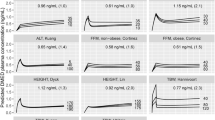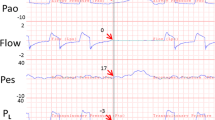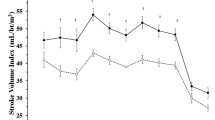Abstract
We investigated whether head up tilt (HUT) with and without simultaneous epinephrine infusion modulate plasma adrenomedullin. We studied eight healthy male volunteers, using two 5 min 70° HUT trials: control (saline infusion) and intervention (epinephrine infusion, titrated to a dose which increased supine systolic pressure by 20% above resting values). Protocols were randomized and separated by 2 weeks. Cardiac function and systolic time intervals, recorded using a phonocardiograph microphone, included left ventricular ejection time (LVET), pre-ejection period (PEP), PEP/LVET and electromechanical systole (QS2). Compared to saline infusion, epinephrine increased supine adrenomedullin (3.2 ± 0.8 pmol/l, i.e., mean ± SEM, respectively), heart rate (HR) (+11.3 ± 2.6 bpm), systolic pressure (+18.4 ± 2.6 mmHg) but decreased supine LVET, LVET corrected for HR (LVETi) and QS2-time (all p = 0.004). Despite similar HUT induced thoracic fluid shifts, reflected by similar thoracic impedance changes, HUT-induced adrenomedullin increases were minimal in epinephrine-supplemented men in comparison to controls (+8% vs. 42%). During HUT, epinephrine infusion decreased only the LVET (p = 0.039). Our findings confirm that short-term HUT increases plasma adrenomedullin. They further suggest that with increased supine epinephrine levels (epinephrine infusion clamping systolic arterial pressure at 120% control level), supine cardiac performance rises to a level similar to that during HUT, while adrenomedullin is still elevated with HUT. This might be in accordance with a ‘dampening’ role of adrenomedullin during catecholaminergic cardiovascular stimulation. As epinephrine is used as a drug to treat cardiac arrest and ventricular arrhythmias, our results may have important clinical/emergency resuscitation applications.



Similar content being viewed by others
References
Brain SD, Grant AD (2004) Vascular actions of calcitonin gene-related peptide and adrenomedullin. Physiol Rev 84:903–934
Carliner NH, Gilbert CA, Puritt AW, Goldberg LI (1974) Effects of maintenance digoxin therapy on systolic time intervals and serum digoxin concentrations. Circulation 50:94–98
Coch D, Dawson G, Fischer KW (2007) Human behavior learning and the developing brain. The Gulford Press, New York
Fellows IW, Macdonald IA, Bennett T, Odonoghue DP (1988) Effect of intravenous infusion of adrenaline on the cardiovascular responses to distal body subatmospheric pressure in man. Clin Sci 75:389–394
Goldstein DS (1983) Plasma catecholamines and essential hypertension—an analytical review. Hypertension 5:86–99
Goswami N, Loeppky JA, Hinghofer-Szalkay H (2008) LBNP: past protocols and technical considerations for experimental design. Aviat Space Environ Med 79:459–471
Goswami N, Lackner HK, Papousek I, Montani JP Jezova D, Hinghofer-Szalkay H (2009a) Effects of mental challenge applied before passive head up tilt on orthostatic neurohormonal responses. Acta Astronaut. doi:10.1016/j.actaastro.2009.09.033
Goswami N, Rössler A, Lackner HK, Schneditz D, Grasser E, Hinghofer-Szalkay H (2009b) Heart rate and stroke volume response patterns to augmented orthostatic stress. Clin Auton Res 19:157–165
Grasser E, Goswami N, Hinghofer-Szalkay G (2009) Presyncopal cardiac contractility and autonomic activity in young healthy males. Physiol Res 58:817–826
Haditsch B, Roessler A, Hinghofer-Szalkay HG (2007) Renal adrenomedullin and high altitude diuresis. Physiol Res 56:779–787
Ihara T, Ikeda U, Tate Y, Ishibashi S, Shimada K (2000) Positive inotropic effects of adrenomedullin on rat papillary muscle. Eur J Pharmacol 390:167–172
Insulander P, Juhlindannfelt A, Freyschuss U, Vallin H (2003) Electrophysiologic effects of mental stress in healthy subjects: a comparison with epinephrine infusion. J Electrocardiol 36:301–309
Ishimitsu T, Ono H, Minami J, Matsuoka H (2006) Pathophysiologic and therapeutic implications of adrenomedullin in cardiovascular disorders. Pharmacol Therap 111:909–927
Isumi Y, Shoji H, Sugo S, Tochimoto T, Yoshioka M, Kangawa K, Matsuo H, Minamino N (1998) Regulation of adrenomedullin production in rat endothelial cells. Endocrinology 139:838–846
Jacobs MC, Lenders JWM, Willemsen JJ, Thien T (1997) Adrenomedullary secretion of epinephrine is increased in mild essential hypertension. Hypertension 29:1303–1308
Johnson AB, Webber J, Mansell P, Gallen I, Allison SP, Macdonald I (1995) Cardiovascular and metabolic responses to adrenaline infusion in patients with short-term hypothyroidism. Clin Endocrinol 43:747–751
Kahan T, Hjemdahl P, Lindvall K, Ostergren J, de Faire U (1998) Adrenaline responsiveness in mild hypertension: No evidence for altered beta-adrenoceptor sensitivity. J Cardiovasc Pharmacol 32:753–759
Kruse HJ, Kreutz R, Lennarz M, Overlack A, Stumpe KO, Kolloch RE (1996) Effects of low-dose epinephrine infusion on cardiovascular and renal responses to water immersion in humans. Am J Hypertension 9:902–908
Krzeminski K, Cybulski G, Nazar K (2009) Relationships between plasma adrenomedullin concentration and systolic time intervals during static handgrip in patients with heart failure. Clin Physiol Funct Imag 29:114–122
Lainchbury JG, Troughton RW, Lewis LK, Yandle TG, Richards AM, Nicholls MG (2000) Hemodynamic, hormonal, and renal effects of short-term adrenomedullin infusion in healthy volunteers. J Clin Endocrinol Metabol 85:1016–1020
Laszlo Z, Rossler A, Hinghofer-Szalkay HG (2001) Cardiovascular and hormonal changes with different angles of head-up tilt in men. Physiol Res 50:71–82
Letizia C, Subioli S, Cerci S, Caliumi C, Verrelli C, Delfini E, Celi M, Scuro L, D’Erasmo E (2002) High plasma adrenomedullin concentrations in patients with high-renin essential hypertension. J Renin-Angiotensin-Aldosterone Syst 3:126–129
Meeran K, Oshea D, Upton PD, Small CJ, Ghatei MA, Byfield PH, Bloom SR (1997) Circulating adrenomedullin does not regulate systemic blood pressure but increases plasma prolactin after intravenous infusion in humans: a pharmacokinetic study. J Clin Endocrinol Metabol 82:95–100
Mink SN, Simons FER, Simons KJ, Becker AB, Duke K (2004) Constant infusion of epinephrine, but not bolus treatment, improves haemodynamic recovery in anaphylactic shock in dogs. Clin Exp Allergy 34:1776–1783
Mizumaki K, Fujiki A, Tani M, Shimono M, Hayashi H, Inoue H (1995) Left ventricular dimensions and autonomic balance during head up tilt differ between patients with isoproteronol dependent and isoproteronol independent neurally mediated syncope. JACC 26:164–173
Nagaya N, Saloh T, Nishikimi T, Uematsu M, Furuichi S, Sakamaki F, Oya H, Kyotani S, Nakanishi N, Goto Y, Masuda Y, Miyatake K, Kangawa K (2000) Hemodynamic, renal, and hormonal effects of adrenomedullin infusion in patients with congestive heart failure. Circulation 101:498–503
Naito T (1986) Abnormal cardiac index measured by means of systolic time intervals and the effect of co-enzyme Q10 in thyroid disorders. Nippon Naibunpi Gakkai Zasshi 62:619–630
Ohta H, Hta H, Tsuji T, Asai S, Sasakura K, Teraoka H, Kitumura K, Kangawa K (1999) One-step direct assay for mature-type adrenomedullin with monoclonal antiibodies. Clin Chem 45:244–251
Persson B, Andersson OK, Hjelmdahl P, Wysocki M, Agerwall S, Wallin G (1989) Adrenaline infusion in man increases muscle sympathetic nerve activity and noradrenaline overflow to plasma. J Hypertens 7:747–756
Rossler A, Laszlo Z, Haditsch B, Hinghofer-Szalkay HG (1999) Orthostatic stimuli rapidly change plasma adrenomedullin in humans. Hypertension 34:1147–1151
Schoen MW, Antman EM, Stricharzt GR, Lilly LS (2007) Cardiovascular drugs. In: Lilly LS (ed) Pathophysiology of heart diseases. Lippincott Williams and WIlkins, Baltimore, pp 397–403
Vijayalakshmi P, Mohan M, Babu PBVPK (2002) Effect of 60degree head-up tilt on systolic time intervals in hypertensive patients. Ind J Physiol Pharmacol 46:45–50
Weissler AM, Garrard CL (1971) Systolic time intervals in cardiac disease I. Mod Concepts Cardiovasc Dis 40:1–4
Xu Y, Krukoff TL (2006) Adrenomedullin in the rostral ventrolateral medulla inhibits baroreflex control of heart rate: a role for protein kinase A. Br J Pharmacol 148:70–77
Acknowledgments
We wish to thank the participants for their time and patience and Andreas Jantscher for his excellent technical support. The study was supported by the Austrian National Bank (Jubiläumsprojekt No 8423), Vienna, Austria.
Conflict of interest
None.
Author information
Authors and Affiliations
Corresponding author
Additional information
Communicated by Dag Linnarsson.
Rights and permissions
About this article
Cite this article
Roessler, A., Goswami, N., Haditsch, B. et al. Modulation of plasma adrenomedullin by epinephrine infusion during head up tilt. Eur J Appl Physiol 111, 531–537 (2011). https://doi.org/10.1007/s00421-010-1668-3
Accepted:
Published:
Issue Date:
DOI: https://doi.org/10.1007/s00421-010-1668-3




